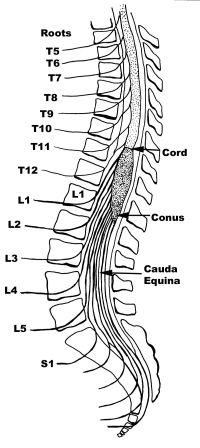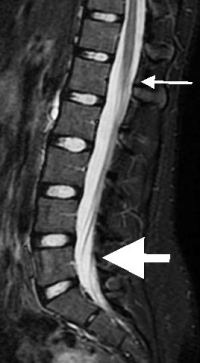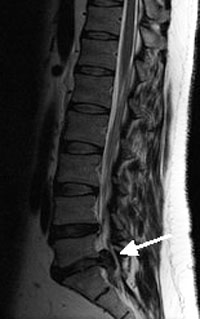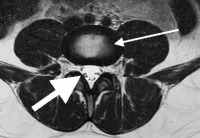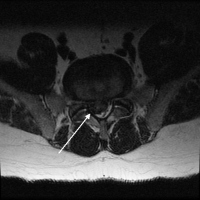An Overview of
The cauda equina is the name for the compilation of nerves that begin at the end of the spinal cord. The spinal cord ends at the upper end of the lumbar spine (at the L1 vertebra). The lumbar spinal canal down below L1 (L2 through the sacrum) contains only nerves and not the spinal cord.
When the Latins first dissected these nerves out of a cadaver, their first impression was the appearance of the nerves as that of a horse’s tail (hence the name “cauda equina” or horse’s tail in Latin). These nerves contain the entire pathway for messaging from the brain down to the hips and feet.
Contained within the cauda equina is a special set of filamentous nerves called the “Nervi Erigantes”. This set of nerves carries signals back and forth from the brain to control the bowel and bladder. These nerves are intermingled with the sensory nerves that give sensation to the skin around the rectum and anus (pudendal nerve S2-4).
What is ?
Cauda equina syndrome develops when the spinal canal is blocked by some type of mass and this set of nerves undergoes significant compression. A massive herniated disc in the lumbar spine is the normal cause of this compression. Other causes of compression that can produce cauda equina syndrome are tumors or fractures. These causes are much more rare.
Although unusual, any action big or small can induce a massive disc herniation. I had one patient simply strain on the toilet. Another patient lifted his two-year-old son. Yet another patient bent over to pick up an envelope. Significant trauma or falls are not necessary to cause this syndrome.
- The set of symptoms of cauda equina syndrome that develop are quite unusual. Typical symptoms of a “normal” disc herniation are leg pain and numbness. The most common symptoms of cauda equina syndrome are:
- Pain and numbness in a distribution around the buttocks in a saddle distribution (the region of skin that would touch a saddle if you were sitting on a horse-called “saddle anesthesia”). This numbness can also involve one or both legs. The legs might feel like they are stiff or “made of wood”. When wiping with toilet paper, the sensation of wiping may be significantly numbed or absent. Weakness of one or both legs. This weakness might make it difficult to walk or to cause a stumble when walking. The feet may not “work right” and may slap on the ground when walking (foot drop).
- Problems with bowel and bladder function. The patient might find it difficult to start (initiate) urination. After a while, this individual might find it difficult to control the urine and the bladder can leak uncontrollably.. Bowel movements may be difficult to control.
Differences Between Cauda Equina Syndrome and Pain or Stress Incontinence
Careful understanding of the bladder symptoms of cauda equina syndrome is important. Many females have a condition that if not careful, can be mistaken for cauda equina syndrome called stress incontinence. This is noted by women with some loss of urine with coughing, sneezing or laughing.
Stress incontinence is due in part to the much shorter urethra (the tube from the bladder to the outside of the body) that females have compared to males. This shorter urethra allows bladder pressure to transmit down the urethra without as much restriction. The actions of coughing or sneezing will increase the pressure in the bladder and this simple pressure increase may force some urine out. Stretching of the pelvic diaphragm (which supports the bladder) due to childbirth can contribute to stress incontinence.
Some individuals will have loss of control of urine associated with pain. These individuals should not be immediately considered to have developed cauda equina syndrome. Back pain can temporarily decrease the ability of the brain to control the sphincter. This is not the same as cauda equina syndrome.
Overflow incontinence is the problem caused by cauda equina syndrome and is very different than stress incontinence. The bladder cannot send signals to the brain regarding the amount of urine contained in the bladder and the bladder overfills. The pressure of the increased urine in the bladder overcomes the strength of the sphincter ,the small muscle that acts like a valve at the end of the urethra. Overfilling of the bladder increases bladder pressure and forces urine to leak out.
Loss of urine associated with numbness around the bladder and rectum as well as pain and weakness of the legs are the symptoms of cauda equina syndrome.
Are you suffering from symptoms of Cauda Equina Syndrome?
Would you like to consult with Dr. Corenman about your condition?
You can set up a long distance consultation to discuss your
current X-rays and/or MRIs for a clinical case review.
(Please keep reading below for more information on this condition.)
Treatment of Cauda Equina Syndrome
The treatment of cauda equina syndrome is a quick diagnosis normally by MRI scan and surgical decompression of the nerves. Normally, this surgery is a microdiscectomy. You can see an example of an actual cauda equina syndrome and decompression surgery by watching the video attached to this section.
To learn more about cauda equina syndrome, please contact the practice of Dr. Donald Corenman, spine surgeon and back specialist offering diagnostic and surgical second opinions to patients in the USA and around the world.

